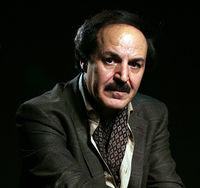Fariborz Lachini: Difference between revisions
No edit summary |
No edit summary |
||
| (4 intermediate revisions by 4 users not shown) | |||
| Line 1: | Line 1: | ||
{{AAType | {{AAType | ||
|Image= | |Image=5853302055 786fc05ef5 z.jpg | ||
|Type=Person | |Type=Person | ||
|import ref=ImportFromWikipedia | |||
|date=July 2010 | |||
}} | }} | ||
Fariborz Lachini is a film score composer originally from Iran based in Canada. | '''Fariborz Lachini''' (, born August 25, 1949) is a [http://en.wikipedia.org/wiki/film_scores film score] [http://en.wikipedia.org/wiki/composer composer] originally from [http://en.wikipedia.org/wiki/Iran Iran] based in [http://en.wikipedia.org/wiki/Canada Canada]. | ||
He started his career in Iran writing music for children, creating "Avaz Faslha va Rangha" at the age of 18 which caught the attention of royal family of the time. The title of national Iranian TV's children programming for more than two decades, was one of his earlier works. Before Iran's Islamic Revolution, he also created music for some of Iran's pop icons. | He started his career in Iran writing music for children, creating "Avaz Faslha va Rangha" at the age of 18 which caught the attention of royal family of the time. The title of national Iranian TV's children programming for more than two decades, was one of his earlier works. Before Iran's Islamic Revolution, he also created music for some of Iran's pop icons. | ||
After the Islamic Revolution he moved to Europe to study Musicology in the Universite de Paris - Sorbonne. It was then that his music became influenced by the European styles. He returned home and created one of the best loved contemporary solo piano albums of all in Iran with a unique style, a combination of Persian and European Romantic styles called "Paeez Talaee", also known as Golden Autumn, which has been the number one seller for years in Iran and has attracted fans from all around the world. | |||
He started composing for motion pictures using the skills and technology acquired in Europe and soon earned himself recognition as a pioneer of computer technology in music in Cinema of Iran. Since 1988, he has scored for more than a hundred feature films, some of which have been showcased internationally in North America, Europe and Asia. | |||
{{From wp|http://en.wikipedia.org/wiki/Fariborz Lachini}} | |||
Image source : | |||
{{From|http:// | {{From|http://www.google.ca/imgres?imgurl=http://farm3.staticflickr.com/2586/5853302055_786fc05ef5_z.jpg&imgrefurl=http://www.flickr.com/photos/kombizz/5853302055/&h=602&w=640&sz=218&tbnid=-IiAA81M9TNB9M:&tbnh=97&tbnw=103&zoom=1&usg=__AmxOKgxQMD54J3tla5GPC30brJw=&docid=NppoLdTMWHXTDM&sa=X&ei=j1KuUc2OLa3K4AO5jYGoBw&ved=0CJwBEP4dMAw}} | ||
Latest revision as of 22:23, 4 June 2013
Person
Fariborz Lachini (, born August 25, 1949) is a film score composer originally from Iran based in Canada.
He started his career in Iran writing music for children, creating "Avaz Faslha va Rangha" at the age of 18 which caught the attention of royal family of the time. The title of national Iranian TV's children programming for more than two decades, was one of his earlier works. Before Iran's Islamic Revolution, he also created music for some of Iran's pop icons.
After the Islamic Revolution he moved to Europe to study Musicology in the Universite de Paris - Sorbonne. It was then that his music became influenced by the European styles. He returned home and created one of the best loved contemporary solo piano albums of all in Iran with a unique style, a combination of Persian and European Romantic styles called "Paeez Talaee", also known as Golden Autumn, which has been the number one seller for years in Iran and has attracted fans from all around the world.
He started composing for motion pictures using the skills and technology acquired in Europe and soon earned himself recognition as a pioneer of computer technology in music in Cinema of Iran. Since 1988, he has scored for more than a hundred feature films, some of which have been showcased internationally in North America, Europe and Asia.
Image source :
